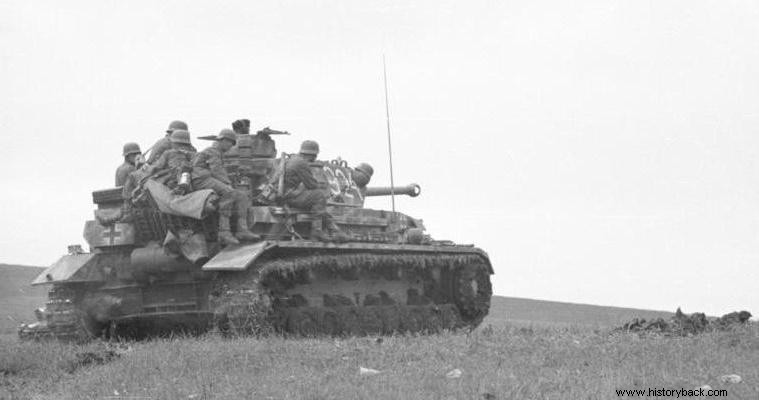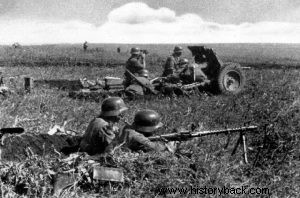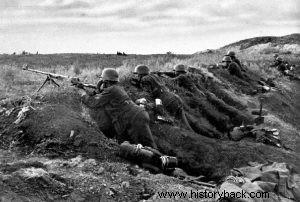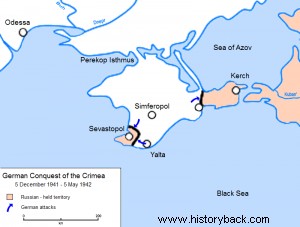
On June 22, 1941, cannons thundered for the first time on the German-Soviet border established in 1939. The two most powerful military machines on the planet faced each other in a colossal conflict that, as Hitler had prophesied, made the world hold its breath.
German forces advanced rapidly into Soviet territory and with a series of successful encirclements crushed the mass of Soviet forces. At the end of August 1941, the highest German leadership was faced with a dilemma.
Two roads opened before her, the road to Moscow and the road to the Ukraine, southern Russia. The Germans chose the South and routed the Soviets in the battles of Kiev and Uman. Soon after, the Germans turned south. In September 1941, the 11th Army, under the leadership of a promising general, Erich von Manstein, was tasked with capturing the Crimea. The 11th Army easily occupied the Crimean peninsula, except for Sevastopol.
Hitler particularly insisted, not unreasonably, that the capture of the Crimea was vital for Germany, because from there the Red Air Force could strike the valuable Romanian oil fields. As early as June 1941, the Red Air Force had carried out raids against Ploesti resulting in the loss of 11,000 tons. oil. The Crimean "aircraft carrier", as Hitler called it, had to fall.
The Germans in the Crimea
On September 25, 1941, the German 11th Army invaded the Crimea. The Soviet forces defending the Perekop Isthmus resisted the Germans for six days, but were eventually forced to abandon their positions.
Soviet forces launched a counterattack from Melitopolis against the Germans, but were repulsed. As if this were not enough Manstein did not allow the Soviets time to regroup. Spearheaded by the 45th and 73rd Infantry Divisions (IP), the 11th Army routed two Soviet armies and advanced into the Crimean interior. Fighting continued until November 16, when German forces captured Simferopol, driving the Soviets out of Crimea.
Only Sevastopol was still under their control . The Soviets, for their part, after the defeat of their forces, hastened the organization of the defense in Sebastopol by enlisting the civilians as well. The first line of defense was created at an average distance of 16 km from the port. Manstein planned to attack Sevastopol immediately, so as not to give the Soviets time to organize their defenses.
However, he failed to implement his plans. The heavens literally opened and the rain fell in torrents for days, turning the ground into a quagmire that forbade troop movement. The Soviets took advantage of the time they were given and moved significant forces to Sevastopol.
The contribution of the Black Sea Fleet and its head, Rear Admiral F. Oktiabritsky, was important. From Novorossiysk thousands of men and material arrived in Sevastopol every day. This made it possible to organize the defensive perimeters in time, before the German attack.
Finally, seven Soviet infantry divisions and six naval brigades (infantry men of the navy) were deployed in Sevastopol.
Also, the garrison of the forts was equivalent to about 12 infantry battalions, while men from the crews of the warships anchored in the port as well as civilians took part in the battle. From the sea, the Black Sea Fleet could support the city with the battleship Paris Commune, three cruisers, eight destroyers, nine minesweepers and 24 submarines. Some of the ships later withdrew and one cruiser and two destroyers were sunk by the initial Luftwaffe raids.
Descent on the back of Manstein
The Battle of Sevastopol formally began on October 30. The Germans launched their first attacks in the first days of November but were repulsed. On December 17, the German forces attempted an even more serious attack against the defensive perimeter. However, the attack was suspended because the Soviets landed in Kerch and Theodosia, taking advantage of their naval superiority.
On December 26, 1942, the Soviet 51st Army began landing at Kerch, on the eastern tip of the Crimean peninsula. About 100,000 Soviet troops landed, in the first phase, in the area and pushed back the overworked German 46th MP and two Romanian brigades that Manstein had stationed there fearing just this possibility.
The commander of the 46th Count von Sponeck, despite Manstein's express orders, retreated in time to avoid being encircled, after the Romanian divisions covering his flanks had retreated, giving the message that heralded the disaster of Stalingrad.
Sponeck was relieved of his duties and sentenced to death by court-martial, but ultimately not executed. However, his move proved to be a lifesaver both for his division and for the German strategic arrangement in the Crimea, since four days after the landing in Kerch, the Soviets also landed in Theodosia, at the southeastern tip of the Crimea. Their goal was to cut off the 11th Army and the Romanian forces and trap them in eastern Crimea.
The 46th MP was in the right position and held the Soviet bridgehead at Theodosia, limiting it around the town of the same name, despite heavy pressure. Meanwhile Manstein abandoned the attack on Sevastopol and turned his attention against the exposed flanks.
He was mainly concerned with the Kerch bridgehead, where the 51st Soviet Army, together with the 44th – and later the 47th – had created a serious threat to his front. Essentially, while until a while ago only Sevastopol was left to resist, now the Germans had to fight and defeat an entire enemy army group while they had behind them the impregnable garrison of Sevastopol.
Especially with the powers at his disposal the problem was very serious even for a Manstein. The 11th Army was already overworked and the strategic surprise suffered by the Soviet landings did not help, just as the Romanian forces which, with the exception of the mountain troops, were far inferior to the German ones in equipment, training and morale, do not help much either.
Von Manstein immediately requested the assistance of the Luftwaffe to cut off the flow of Soviet reinforcements and launched a counterattack against the Theodosia bridgehead, which he eliminated on January 18, 1942 . At the same time, he strengthened the Kerch front by moving General Hansen's LIV Army Corps against the Soviet 51st and 44th Armies.
The loss of Theodosia forced the Soviets to concentrate their forces in Kerch. Their goal was now to definitively eliminate the German threat against Sevastopol, "breaking" the siege. From the beginning of February the Crimean Front (equivalent to Army Group formation), as it was called, launched a series of attacks against German positions, which continued in March and April. All were repelled with heavy losses for the Soviets.
But the Germans were also pressed by the weight of the Soviet attacks and their units were severely tested. Since March, when the weather had improved, the Luftwaffe intensified its action, having as its primary objective the isolation of the battlefield and the interruption of the flow of reinforcements and supplies to the Soviet forces.
March and April 1942 proved to be disastrous months for the Soviet Navy. 15 ships with a total displacement of more than 27,000 t.were lost In addition to the air campaign, it must be said that the Soviet command depleted its forces with the continuous fruitless and stereotypical attacks against the German positions. The results of this wear and tear would soon be seen.
Prey and aggressor
Manstein having faced the enemy attacks decided to clear up the situation once and for all. That's how he planned the operation "Hunting wild turkey". A fanatical hunter himself, he would turn the Soviets from aggressors into prey. The Luftwaffe had succeeded in isolating the Soviet armies in the Crimea, depriving them of critical supplies, food and fuel.
Soviet generals suggested to Stalin the withdrawal of the three Soviet armies of the Crimean Front from the peninsula, but he refused and instead ordered a new liberating offensive to be prepared. On May 6 he changed his mind and ordered the defense of the armies in the occupied positions until the end.
The head of the Crimean Front, General Kozlov, had at the beginning of May at the northern end of the bridgehead the 51st Army with eight divisions and three infantry brigades and two armored brigades, at the southern end the 44th Army with five infantry divisions and two armored brigades and the 47th Army as reserve with four divisions of infantry and one of cavalry.
The northern front was covered by extensive marshes. Kozlov generally did not expect the enemy to venture an attack, since his forces were twice the German and the terrain, especially in the northern sector, favored him.
But Manstein had a different opinion. He gathered what he had in his hands, five infantry divisions and the 22nd Panzer Division (22nd MPa) allocated to him for this purpose and at 04.15 on 8 May 1942 he threw them against the Soviet 44th Army. At the same time the entire 8th Air Corps of Rear Admiral Richthofen launched an unprecedented air storm against the hapless Soviet army. Command stations, artillery positions, emplacements, depots, everything was pulverized.
In this inferno of fire the Soviet soldiers, without guidance, since the army headquarters had also been leveled, fled in disorder with the first German attack. At the same time, the 436th Regiment of the German 132nd MP landed in the rear of the Soviets in ships and increased the confusion and panic. Within three hours the Soviet 44th Army had ceased to exist!
Manstein's strike was overwhelming, costing just 104 dead and 284 wounded. It was one of the greatest victories in history already . But worse was to come for the Soviets. General Kozlov was too late to realize the magnitude of the calamity that had befallen his army group and did not reorganize the 51st Army in time mainly, whose backs, completely uncovered, provoked the German advance.
And indeed Manstein did not miss the opportunity. He immediately directed the 22nd Army into the rear of the Soviet army, disrupting any organic link between its units and trapping it between the German XXX Corps and the sea. The 51st Army was forced to lay down its arms and surrender.
The Soviets tried to save the 47th Army, but that was not possible either. The panic that prevailed and was aggravated by the continuous raids of the Luftwaffe was indescribable and paralyzed soldiers and administrations.
With superhuman efforts and great sacrifices of the Red Air Force and the Navy, the rescue of 116,000 men was achieved. Yet another 170,000 were killed or captured. The Germans had 600 dead and 3,100 wounded . They lost three assault guns, eight tanks and nine field guns. It was an incredible triumph.

Map of Kerch operations and Manstein's counterattack.

General (later field marshal) Erich von Manstein (second from the right with the doublet).

Soviet prisoners.

German soldiers with MG34 machine gun and RAK 36 anti-tank gun.

German infantry in battle positions. The one on the left carries an anti-tank rifle.

Romanian troops.

The strategic situation in the Crimea after the Soviet landing in Kerch.
